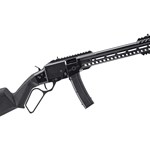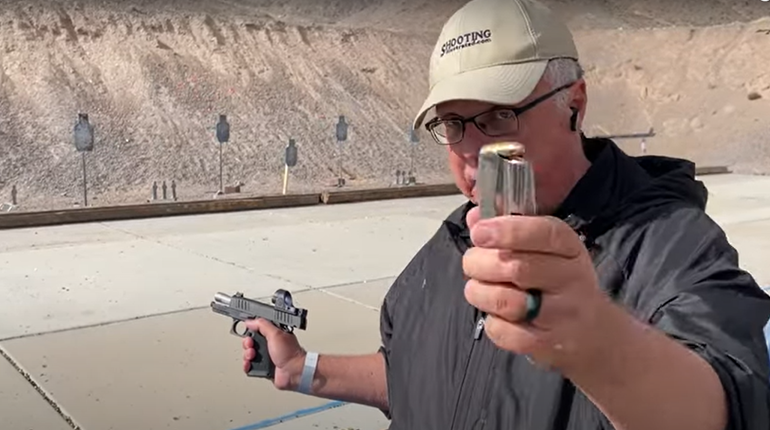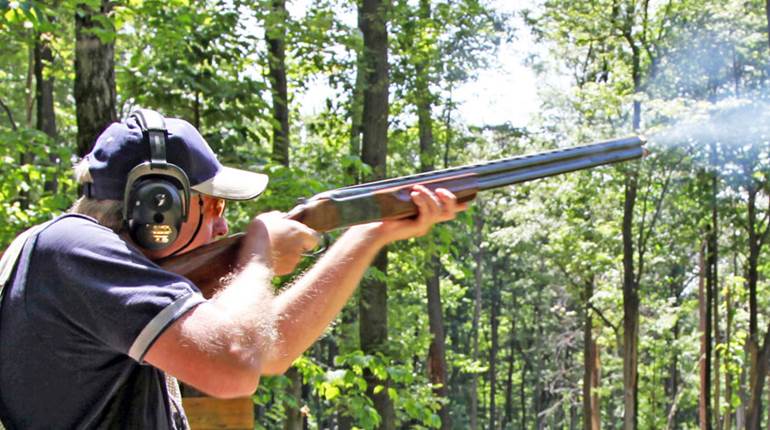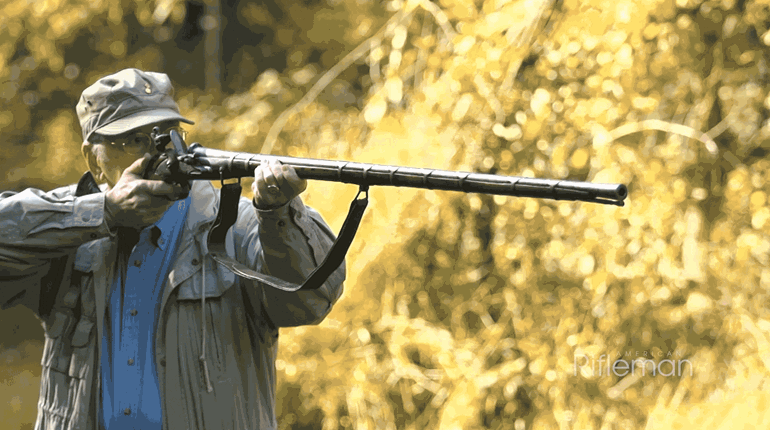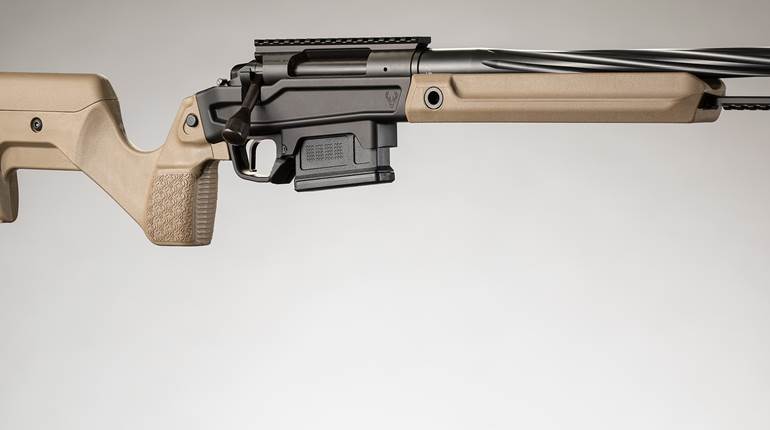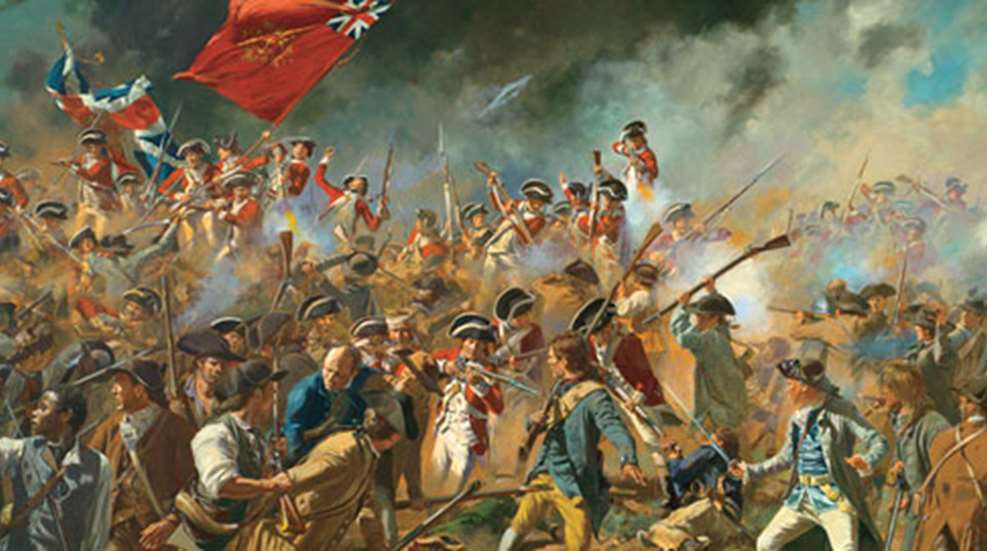
Painting by Don Troiani
Some historians have perpetuated myths about the men and guns of the American Revolution, taking aim at American marksmanship. But recent scholarship shows that the citizen soldiers who fought at the Battle of Bunker Hill were far better shots than the “professional” British soldiers who faced them. Just how good were they? Read on.
A now forgotten Prussian artillerist of the 19th century, one Col. Schlimmbach, devoted many beetle-browed hours to calculating precisely that during the Napoleonic Wars (c.1799-1815) the enemy needed to fire “a man’s own weight” in bullets before scoring a hit. Assuming, then, that he survived both disease and cannon shot, the typical soldier who fought in just a few battles could be fairly certain of enjoying a peaceful, pensioned retirement.
The same could not be said for those British troops fighting the American militia in the early stages of the War of Independence. They stood a dismayingly good chance of being shot by the end of a single engagement. The marksmanship of the American fighting man has a long and storied tradition in our nation’s history. Since the Revolutionary era, Americans have assumed that they are, shot for shot, the finest marksmen on the planet.
It was only in the decade preceding World War II that the “myth” of American marksmanship first received incoming fire from historians, especially as it pertained to the War of Independence—the hammer and anvil of the American character. In 1934, Allen French’s otherwise magisterial The First Year of the American Revolution claimed that owing to “poor American guns, and the men’s lack of practice ... too much has been made of American marksmanship” in the critical year of 1775, when the militia fought at Lexington/Concord and Bunker Hill.
French’s dismissal of American expertise was echoed by Christopher Ward in his popular War of the Revolution of 1952. He concluded that at Lexington/Concord, “only one bullet out of 300 found its mark,” so demonstrating “the fallaciousness of the belief so often expressed that the Yankees were superior marksmen, dead shots in fact.”
Through time, this once-radical view has become conventional wisdom, even among the most painstaking of historians. In his detailed Battle of Bunker’s Hill (1975) John Elting went so far as to assert that “at best the average New Englander [in 1775] ... could load and fire a musket with a fair chance of hitting an easy target at short range. But this made him probably as good a shot as the average French or Prussian veteran.”
More recently, Michael Stephenson’s Patriot Battles (2007) asserted that in 1775 the militia were “indifferent shots when one considers the number of militia involved, the time available to them, the vulnerability of the target, and the relatively low ratio of British casualties to the shots fired.”
Now, good history-writing hinges on debate and reinterpretation, but in this case political axe-grinding has begun to intrude. Michael Bellesiles, a Second Amendment critic whose best-selling manifesto, Arming America, has been severely discredited for a multitude of sins, argued that “a total of 3,763 Americans are known to have participated [at Lexington]. Not all of them held guns, and not all fired, but among them they hit 273 British. Expert marksmanship requires training, good equipment, and a regular supply of ammunition for practice. These farmers rarely practiced, generally had no ammunition, and owned old muskets, not rifles, if they owned a gun at all.” The implication is that “these farmers” could not hit their own barndoors, such atrocious shots were they.
Before moving on to the real meat of the matter—the issue of marksmanship—let’s clear up a few errors in the conventional wisdom. First, the American militiamen were not “out of practice” in the lead-up to war. From the fall of 1774 onward, most New England militia companies were assembling for serious target practice at least twice and more often thrice a week. If anything, it was the British who rarely practiced. Lieutenant Williams of the 23rd Regiment caustically observed that his troops “foolishly imagine that when danger is feared they [should] secure themselves by discharging their muskets, with or without aim.” As late as three days before Bunker Hill, most British infantrymen still had not been taught how to “fire ball,” take aim, and stand properly, let alone been put through target practice.
What about the “old” and “poor” American guns? Absolutely, the muskets they brought to the fight had seen better days. One veteran remembered, “Here an old soldier carried a heavy Queen’s arm, with which he had done service at the conquest of Canada twenty years previous, while by his side walked a stripling boy, with a Spanish fuzee not half its weight or calibre, which his grandfather may have taken at the Havana [1762], while not a few had old French pieces, that dated back to the reduction of Louisburg [1758].”
Yet the antiquity of the militiamen’s pieces should not obscure their lethality. These were working, effective, well-maintained arms. In an era when guns were expensive and difficult to make it was common for even regular soldiers to use hand-me-downs. The British, for instance, were using muskets—still perfectly serviceable—dating as far back as 1742. It is not the gun that matters, we should remember, but the man behind it, and in 1775 the American militias were packed with veterans blooded in the French and Indian War (1754-1763) and boasting plenty of firefights (and scalps) under their belts. These were hard men who knew their business, not green innocents plucked from the fields panicked into firing harmlessly into the air.
As for not owning guns in the first place, this claim too can be discounted. Virtually every man at Lexington/Concord and Bunker Hill brought a firearm. Deducing exact figures for gun ownership in 1775 is extremely difficult. However, an analysis of the returns of 30 New England militia companies finds that the overall rate of private ownership was about 75 percent, and probably significantly higher. Any man who wished to fight either carried his own gun, used one provided by his township or, in a pinch, borrowed a piece from a neighbor.
Their “unfamiliarity” with shoulder arms is another baseless myth. The militias’ arms were treasured tools used every day for hunting and protection. Israel Litchfield, a Massachusetts militiaman, keenly maintained his musket and its accoutrements. According to his diary, he prepared for the worst on March 10, 1775, when he “scoured up my gun” to clear the fouling in the barrel (from shooting at targets) before taking it to Hezekiah Hutson, the local gunsmith, to “put in a new main-spring into my lock.” On March 21, Litchfield fine-tuned the amount of gunpowder he needed to be effective at 100 yards by spending the whole day “cleaning the lock and fixing her. After I had cleaned and oiled the lock I put in a good flint and tried her to burn three corns [grains] of powder. I cocked her and snapped and she burned them. I told out just three corns and tried her again and she burned it so I tried her eleven times successfully and she burnt three corns of powder every time and did not miss. The 12th time she missed them but I overhauled and cocked her and she burnt them the next time.”
These are not the actions of a man unfamiliar with firearms. But did he and his brethren know how to use them accurately? It is undoubtedly true that not all the Americans were “dead shots,” in Ward’s words, but a significant number were highly proficient shooters by the standards of the time.
Put simply, the modern criticisms of the militia stem from a fundamental misunderstanding of the nature of 18th-century marksmanship and musketry. The error is compounded by unfavorably comparing yesteryear’s standards to those of today, a categorical mistake that is like complaining how on a racetrack the Model T Ford cannot even keep pace against the latest Ferrari.
Today, a military-grade rifle, such as the FN SCAR, will group five shots at 100 yards within a 1.29-inch circle. Then, however, the British officially believed that shooters were exhibiting a “high degree of precision” when one of every five or six rounds from a Brown Bess musket hit a three-foot wide target at that distance. In other words, when at least 80 percent of their shots missed a yard-wide bullseye at what was regarded as the optimal combat range, contemporaries praised such performance as extraordinarily good. It is against this standard, not the FN SCAR’s, that we must contrast American marksmanship.
There are many reasons for this relatively poor performance. Essentially, it was exceedingly difficult to hit the same specific place more than once with any predictability. Muskets were each hand-made, entailing that one was not identical to another—even when manufactured by the same gunsmith. Quality of construction, the type of wood and iron, the length of the barrel, the placement of the sights, the tightness of the screws, the solidity of the firing mechanism, the pull of the trigger and the weight of the gun: All varied immensely and all exerted an influence on performance.
So too was there no universal standard for gunpowder and projectiles. Different weights and faulty casting (which caused air pockets in the lead) made it impossible to predict how far the ball would fly and along which particular vector, as did improper measuring and mixing of the powder.
Moreover, in order to ease loading, the barrel’s bore was larger than the ball, meaning that when the gun was fired, the projectile would exit erratically from the point of last contact at the muzzle.
All things considered, then, even if one’s last shot hit the target square on, there was no guarantee that the next would not end up three feet away. As a saying sorrowfully beloved of musketmen went, “One went high, one went low, and where in Hell did the other one go?”
American shooting, however, somewhat overcame these disadvantages by dint of long experience, a lot of practice, and personal knowledge of a gun’s idiosyncrasies. Thus, during target practice Capt. Samuel Stockbridge (according to Litchfield) calmly “shot at a mark about 12 or 14 rods [about 70 yards away] and hit it exactly within an inch.” He, like Litchfield, knew every inch of his gun.
Stockbridge’s talents were evidently not uncommon. Licking their wounds, the British were staggered by the relative precision of American shooters. Sergeant Roger Lamb of the Fusiliers judged that “the generality of the Americans were good marksmen; the whole of their previous military knowledge had been derived from hunting, and the ordinary amusements of sportsmen. The dexterity which by long habit they had acquired in hitting beasts, birds, and marks, was fatally applied” during 1775.
Accordingly, at the Battle of Bunker Hill, American commanders were so confident in their troops’ marksmanship that “every platoon officer was engaged in discharging his own musket and left his men to fire as they pleased,” trusting them not to waste their shots. Which was why, as veteran Henry Dearborn recalled, his comrades never fired “without a sure aim at some particular object.”
That “particular object” happened to be enemy officers, the intention being to disrupt and demoralize the foe. Colonel Prescott—who was defending the redoubt from British assaults—ordered his militiamen to “take particular notice of the fine coats” and concentrate on them. They must have, for after the battle the British noticed that among their hit officers “few had less than three or four wounds,” indicating that each was the reluctant subject of several Americans’ attention. Only men who could be counted on to hit their targets would be granted the leeway to aim at individuals rather than firing into the mass. Indeed, at Bunker Hill, every one of the 12 staff officers escorting the British commander Gen. Howe was either killed or wounded.
Anecdotally, then, it is clear that the Americans were deemed to be fine shots. But is there any statistical evidence of this fact? To a degree, yes. Let us assume that there were, as the most authoritative estimates have it, 3,500 Americans at Bunker Hill, each of whom began the battle with his official allotment of 15 rounds. As we know that the powder and ball more-or-less ran out near the end, we can posit that the militiamen expended 52,500 shots (3,500 men multiplied by 15 rounds each).
Almost certainly this figure is too high—not every man fired half as many times—but some militiamen fired much more often than that using extra rounds brought from home, scavenged from the wounded, or borrowed from a friend. So, for the sake of simplicity, we can accept these two factors as canceling each other out.
The British totaled up their casualties as 228 killed and 826 wounded, or 1,054 in total. Dividing the number of casualties by the number of shots needed to inflict them gives us a ratio of one for every 50 rounds. Expressed differently, two percent of the Americans’ shots hit the enemy.
On the face of it, that may not sound too impressive, let alone provide evidence of superior marksmanship, but comparatively speaking, it was a truly remarkable performance. If we take the average estimate of seven 18th- and 19th-century European military experts of how many balls hit their targets in battles during this period, we arrive at a figure of 0.17 percent, or fewer than one out of every 500 fired. Sir Richard Henegan, for instance, a senior officer serving under the Duke of Wellington during the Napoleonic Wars, calculated that just one out of every 459 British bullets hit an enemy soldier at the 1813 Battle of Vittoria.
Extrapolating from the 0.17-percent average, we can surmise that the Americans were nearly 12 times as effective at hitting their foe than British or European soldiers. Even if we accept Christopher Ward’s censorious—and heavily flawed—computation of one hit in 300 (0.33 percent) at Lexington/Concord, militia marksmanship was still twice as good as that of the Redcoats.
Militiamen were not perfect. They were citizen short-term irregulars, not long-service professional troops, and they neither took orders kindly nor could face an infantry assault in the open field. But in 1775 they did know how to shoot. Given their achievements, it is time, surely, to stop heaping calumnies upon their heads and take to heart instead the advice given by the Revolutionary soldier Col. Grayson. He likened the boys of Lexington and Bunker Hill to the “price of a wife: Be to their faults a little blind, And to their virtues very kind.”
Alexander Rose is the author of American Rifle: A Biography and Washington’s Spies: The Story of America’s First Spy Ring. His website is www.alexrose.com.









